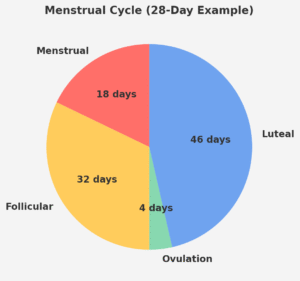Period calculator
This period calculator helps estimate your upcoming period dates and most likely ovulation days based on your cycle length and the first day of your last period.
Related calculators:
Menstrual cycle
The menstrual cycle is the body’s natural monthly process that prepares for the possibility of pregnancy. It begins at puberty (usually between ages 12–15) and continues until menopause, which typically occurs between ages 49 and 52. A cycle is counted from the first day of one period to the first day of the next, and while the average cycle lasts about 28 days, normal cycles can range from 21 to 35 days.
Hormones guide each stage of the cycle. In a typical month, the uterus builds up its lining, the ovaries release an egg, and the body prepares either for pregnancy or for the start of a new cycle.
While every person’s cycle is unique, most follow the same four main phases. The visuals below show both a circular “at-a-glance” view and a linear, day-by-day timeline.
The cycle at a glance

The menstrual cycle repeats in four phases. This circular chart shows their typical length in a 28-day cycle.
- Menstrual phase (≈5 days): Shedding of the uterine lining (your period).
- Follicular phase (≈9 days): The uterine lining rebuilds, and an egg matures in the ovary.
- Ovulation (≈1 day): The egg is released and fertility is highest.
- Luteal phase (≈13 days): The body prepares for pregnancy; if no fertilization occurs, the cycle restarts.
Phase-by-phase breakdown
- Menstrual phase (Days 1–5)
The cycle begins with menstruation, commonly called a period. The uterine lining sheds and exits the body through the vagina. Bleeding usually lasts 2–7 days. - Follicular phase (Days 1–13)
Overlaps with menstruation at the start. The ovaries begin to develop follicles, and one egg matures. Rising estrogen helps the uterine lining rebuild. - Ovulation (Day 14 in a 28-day cycle)
A surge in luteinizing hormone (LH) triggers the release of the egg. This is the most fertile time, covering the 5 days before ovulation and up to 1–2 days after. - Luteal phase (Days 15–28)
After ovulation, progesterone supports the uterine lining. If the egg is not fertilized, hormone levels drop, leading to a new period. Premenstrual symptoms (PMS) often occur during this phase.
The cycle day by day

- Days 1–5: Menstrual phase
- Days 6–13: Follicular phase
- Day 14: Ovulation
- Days 15–28: Luteal phase
Key points to remember
- Cycle length varies: 28 days is just an average.
- Ovulation marks peak fertility: The best chance of pregnancy is during the ovulation window.
- Periods stop: During pregnancy, breastfeeding, and permanently at menopause.
